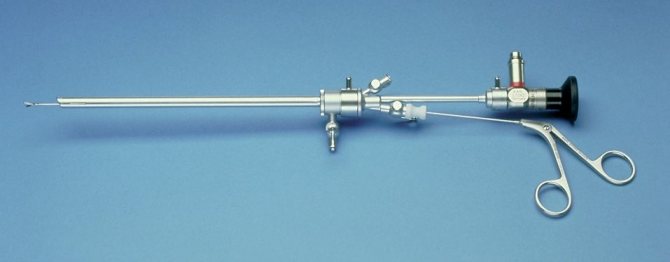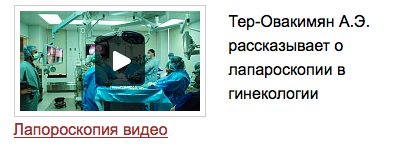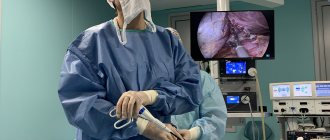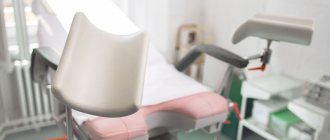Hysterosalpingography is a procedure that is performed to diagnose diseases of the uterus and fallopian tubes, as well as to assess their patency. When diagnosed with infertility, this is one of the first examinations that are usually prescribed to women. In this study, a woman is injected with a contrast agent into the cavity of the uterus and fallopian tubes, and then the condition of these organs is assessed using X-rays or ultrasound. The contrast allows you to see whether the egg can pass through the tubes, or whether there are adhesions or scars that prevent this.
Pros and cons of hysteroscopy of the uterus before IVF
One of the main reasons for IVF failure is that the embryo cannot attach to the walls of the uterus. This may be due to thickening of the endometrium, the presence of cysts, polyps and other pathological changes. Hysteroscopy first of all makes it possible to detect abnormalities and, as a result, promptly eliminate them, thereby increasing a woman’s chances of pregnancy. Plus, when carrying out this kind of diagnosis, the uterine endometrium is inevitably injured, but this only activates the growth of the functional layer of the uterus. The result is successful IVF after hysteroscopy.

IVF after hysteroscopy
Some experts are against this procedure. The main argument is the absence of direct indications: if the patient’s medical history does not provide accurate evidence that pathological changes are detected in the uterine cavity, there is no need to do hysteroscopy. Among the disadvantages of this diagnostic method are:
- the need for anesthesia, which not all women tolerate easily;
- increased costs for preparation for IVF (the procedure is paid).
The effect of HSG on pregnancy
Above, we described in detail what HSC is, only to more clearly show its role in pregnancy planning. In addition to its diagnostic value, hysterosalpingography can also play a role as a therapeutic procedure. Often after HSG you can get pregnant quite quickly, even if no other treatment methods were used. This is because the contrast entering the uterus actually flushes the tubes and is then released into the abdominal cavity. Small adhesions that worsened patency disappear, and the likelihood of conception increases. Unfortunately, the effect of this procedure is short-lived - it lasts only a few months. Therefore, you should not delay planning pregnancy after HSG.
If the problem of infertility lies in something else, hysterosalpingography will not help. However, this diagnostic procedure will allow you to exclude tubal obstruction and focus on finding the correct diagnosis. GHA will not help either if the woman has complete obstruction. But it is after diagnosis that the doctor will be able to offer you therapeutic or surgical treatment and prescribe medications.
How is hysteroscopy done before IVF?
Preparation for the operation is simple. The main requirement for the patient is not to eat immediately before the procedure. Previously, the woman is prescribed an examination by a gynecologist and tests, based on the results of which the doctor can determine contraindications (inflammation and infections of the genital organs, chronic somatic diseases). Laboratory tests include:
- general analysis of urine and blood;
- biochemistry, coagulogram;
- fluorography, ECG;
- tests for HIV, syphilis, hepatitis B and C;
- bacterioscopy of vaginal discharge;
- determination of blood group and Rh factor.
If the results are unsatisfactory, therapy is first carried out, at the end of which a re-examination is prescribed.
Everyone who had hysteroscopy before IVF noted that they did not experience severe pain. In some cases, it takes place without anesthesia at all, and, as a rule, within an hour the unpleasant sensations in the lower abdomen disappear.
The procedure lasts 20–30 minutes and is performed on a gynecological chair. The patient is given anesthesia intravenously. Through the cervix, bypassing the vagina, the doctor inserts a special instrument - a hysteroscope. Also, air or a special salt solution is directed inside under pressure. This is necessary to expand the walls of the uterus and better see the endometrium.

How is hysteroscopy done?
The optical device transmits the image to the computer screen. If necessary, the doctor can enlarge the picture to examine the condition of the tissues in detail. To remove polyps, adhesions, etc., as well as to collect material for biopsy and diagnostic curettage, the gynecologist surgeon uses flexible scissors, forceps, and an electrocoagulator.
Consequences of the procedure
Despite the fact that hysteroscopy is considered a gentle method of treatment, complications also develop with its use. After this, the consequences are as follows:
- Perforation of the uterus
- Bleeding
- Side effect of anesthesia
- Endometritis
Consequences in the form of uterine perforation rarely occur; most often, such a complication arises due to the low qualifications of the doctor, as a result of perforation of the uterine wall with a hysteroscope.
Consequences in the form of bleeding occur due to various causes and factors; if heavy discharge occurs, a woman should urgently consult a doctor.
Consequences in the form of endometritis or inflammation of the uterus arise due to an infection introduced during the procedure, due to an inflammatory process that was not treated before the procedure.
Consequences in the form of a hematometer develop due to uterine spasm during the procedure.
Also, a complication after the procedure is considered to be an incompletely removed polyp, a myomatous node, which is rare.
IVF after hysteroscopy
Many people are concerned about the question: how long after hysteroscopy can IVF be done? Everything will be determined by the result obtained. If there are no abnormalities, in vitro fertilization is performed immediately after the end of the next menstruation. If diagnostic hysteroscopy shows the presence of neoplasms and turns into surgery, IVF is done after complete restoration of the endometrium. As a rule, this takes from 2 to 5 months. During this period, hormonal treatment and anti-inflammatory drugs are prescribed. At the end of the course, another examination is often carried out.

Is successful IVF possible after hysteroscopy?
Hysteroscopy before IVF increases the chances of pregnancy. It is not mandatory, and its necessity is determined by the attending physician.
Video: hysteroscopy before IVF - a story about personal experience
Indications for hysteroscopy
The following symptoms and diseases are indications for the procedure:
- Heavy, painful menstruation
- Uterine bleeding
- Infertility
- Endometriosis
- Endometrial hyperplasia
- Suspicion of synechia
- Myoma
- Polyps
- Inability of a woman to carry a pregnancy to term
- Suspicion of cancer
- Clarifying the location of the intrauterine device and its removal
- Examination of the uterus after surgery
- Removing the remnants of the fertilized egg after termination of pregnancy
What happens after uterine fibroids
If you were diagnosed with uterine fibroids at an appointment with a gynecologist, you should not panic and run to a surgeon for removal. This is a benign tumor that requires constant monitoring. You will be advised to avoid stressful situations, lead a calm, healthy lifestyle, try to catch fewer colds, and not overdo sports. The gynecologist will monitor the size of the tumor and observe its dynamics. Many women live their whole lives with this diagnosis and do not undergo surgical interventions with proper therapy.
As our practice shows, after uterine fibroids you can get pregnant and bear a healthy baby. Our doctors will do everything to ensure that your women's health is strong and does not cause you concern. To do this, you just need to come to us for regular appointments. You can make an appointment with a gynecologist by calling our clinics:
- Clinic in Maryina Roshcha 8 (495) 221-21-16
- Clinic in Mitino 8
- Clinic in Tekstilshchiki 8 (499) 322-23-97
- Clinic on Shchelkovskaya 8 (495) 221-21-14
What is an endometrial polyp
An endometrial polyp is a benign formation that is formed from endometrial cells. When the cells that make up the endometrium grow excessively, they can become denser, forming a polyp. In this case, one or more polyps may appear. The size of polyps varies from a few millimeters to several centimeters. The polyp consists of a body and a stalk. The leg is attached to the uterus and contains many vessels through which the polyp is nourished.
Since the polyp consists of endometrial cells, it has a structure similar to it (glands and fibrous tissue). This makes the polyp a benign formation. However, if there are atypical cells or adenomatous structures (altered glands) in it, the polyp begins to pose a threat and is considered a precancerous condition. Also, some forms of endometrial cancer are similar in appearance to a polyp, so the removed polyp must be sent for histological examination.
Symptoms of endometrial polyp
In many cases, an endometrial polyp can be asymptomatic and detected only during a routine gynecological examination. If an endometrial polyp is associated with hormonal imbalance and the development of hyperplasia, then it may have the following clinical manifestations:
- menstrual irregularities;
- intermenstrual bleeding (heavy or mild);
- heavy discharge during menstruation;
- discharge with clots in girls during puberty;
- bleeding in postmenopausal women;
- pain in the lower abdomen with large polyps;
- pain during and after sexual intercourse;
- infertility.
Pregnancy after laparoscopy, menstruation after laparoscopy

Laparoscopy is the most effective solution to eliminate such an urgent problem as infertility. Of course, a woman’s first question after surgery is: “When will I get pregnant?”
Typically, pregnancy after laparoscopy occurs in the coming months. But, you should not expect that after you leave the hospital, you will immediately become pregnant. No. This is an individual question. The patient continues to be monitored by her attending physician. Sometimes medication support is required in order to maintain normal hormonal levels during pregnancy. However, much depends on the previous diagnosis. It is also possible that before laparoscopy the woman had certain problems related to her health. Therefore, before undergoing treatment, it is necessary to eliminate them all. But it is worth noting that even healthy women may not become pregnant for a long time. The likelihood of pregnancy after laparoscopy is influenced by the doctor’s competence and the individual characteristics of your body.
It is best to start conceiving 1 month after the operation, that is, from the next menstrual cycle. Maintain sexual rest for 3 weeks to avoid the risk of infection and take care of yourself.
After the operation, two small scars remain. One of them is located in the navel area, and the other on the upper border of the pubis. Over time, they will disappear, since the diameter of the cannulas used to make the puncture is very small.
Within a month, the woman’s body is completely restored, ready to conceive and bear a child. Do not forget that a year is the optimal period for conceiving a baby. If you were unable to get pregnant during this period, we advise you to contact your doctor at the clinic to undergo additional examination. Remember, pregnancy after laparoscopy should be under the strict supervision of your doctor.
In very rare cases, pregnancy does not occur after laparoscopy. But don't despair! Laparoscopy does not cause any harm to the body, so there is no need to worry about it. The body is individual, and if all foci of the disease cannot be eliminated the first time, the operation is repeated.
In fact, the pregnancy rate after laparoscopy is 85%. Therefore, the likelihood that you will find yourself among this percentage of women is very high!

As for menstruation, in the absence of complications, there is no delay. Laparoscopy is usually performed on days 7-10 of the cycle, before ovulation. You may experience heavy discharge after surgery that is similar to your menstrual period. This bleeding can last up to 3 weeks. But even if your period is a little late, there is nothing terrible about it. Since after this period the cycle is restored.
Treat your health with due attention; do not neglect visiting a gynecologist. Therefore, it is better to postpone pregnancy after laparoscopy for at least two to three months. And only then begin to continue the family line. All in your hands!
Have questions about laparoscopy and pregnancy? Call a consultant, 979-00-00 or ask a doctor a question.
What is endometrium
The endometrium is the inner lining of the uterus. It consists of glands and fibrous tissue and has two main layers: basal and functional. The endometrium creates the necessary conditions for implantation of a fertilized egg (blastocyst). Changes occur in the endometrium every month under the influence of sex hormones. Its cells, glandular and epithelial, begin to gradually grow, preparing for implantation. Thus, the functional layer of the endometrium reaches its maximum during the period of ovulation.
When a blastocyst is implanted into the endometrium, the body begins preparations for bearing a new life. Numerous blood vessels of the endometrium will subsequently be part of the fetal placenta, which provides nutrition and oxygen supply. Also in the body, the content of human chorionic gonadotropin and progesterone significantly increases, which support pregnancy in the first trimester and do not allow the endometrium to be rejected.
If pregnancy, i.e. implantation of the blastocyst has not occurred, the endometrium begins to gradually thin out. About 10 days after ovulation, the endometrium is shed, causing menstruation: the functional layer leaves the uterine cavity. With the beginning of a new cycle, the endometrium begins to grow again due to cells that are located in the basal layer.









